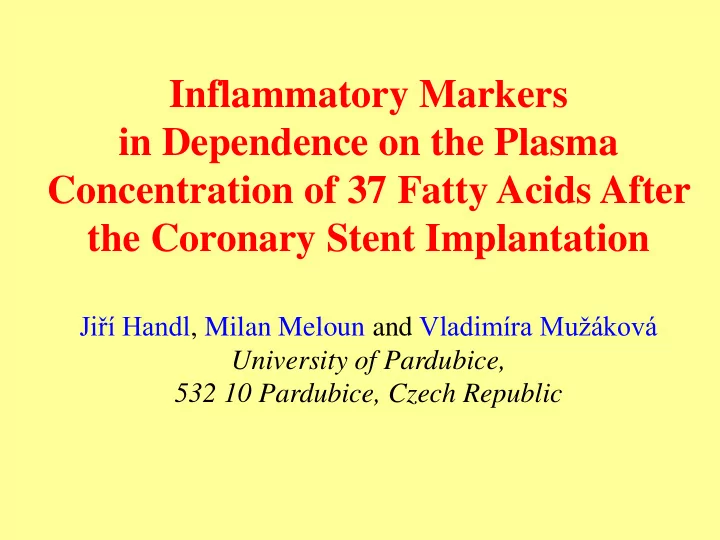

Inflammatory Markers in Dependence on the Plasma Concentration of 37 Fatty Acids After the Coronary Stent Implantation Jiří Handl , Milan Meloun and Vladimíra Mužáková University of Pardubice, 532 10 Pardubice, Czech Republic
Goal of article Inflammatory Markers in Dependence on the Plasma Concentration of 37 Fatty Acids After the Coronary Stent Implantation Using the regression model building the relations between the concentration of 37 fatty acids of blood plasma phospholipids of 41 patients with coronary artery disease after coronary stent implantation, and the inflammatory response and oxidative stress markers were estimated. 2
Highlights Regression testifies the strength of positive/negative relationship of the fatty acid on markers. Selected markers were C-reactive protein, interleukin-6, malondialdehyde and serum amyloid A. Factor analysis and cluster analysis separated 37 fatty acids into clusters of similar properties. The box plot revealed in fatty acids the largest concentration variation in phospholipid fraction. 3
The Box-and-whisker plot tests the variability of the concentration of 37 fatty acids examined. 4
Estimated concentration [µ mol/l] of 37 fatty acids in 41 patients 5
test the concentration of 37 fatty acids, Stars i.e. here the beam-length in 41 patients studied. The length of a beam The index of patient 6
Polygons test concentration of 37 fatty acids, i.e. here the beam-length in 41 patients. 7
Factor analysis provides the plot of factor loadings after varimax rotation forming clusters of the concentration of fatty acids. The factors are named according to fatty acids located near factor axes. 8
Cluster Analysis Dendrogram of variables (i.e. the concentration of fatty acids) shows clusters of similar variables. 9
Factor Analysis The plot of factor scores explaines 37 features concerning a similarity of all patients classified in clusters. 10
Cluster Analysis The dendrogram of clusters scores explaines 37 features concerning all patients. The similarity of 41 patients are examined using clusters of similar objects. 11
R egression model ∆CRP : The linear regression model building and testing forms the regression model ∆CRP = β 0 + β 1 x 1 + β 2 x 2 … + β 37 x 37 concerning a dependence of ∆CRP on the concentration of each of 37 fatty acids. The fatty acids are present in table according to their significant slope β . 12
R egression model ∆ MDA: The linear regression model building and testing forms the regression model ∆ MDA = β 0 + β 1 x 1 + β 2 x 2 … + β 37 x 37 concerning a dependence of ∆ MDA on the concentration of each of 37 fatty acids. The fatty acids are present in table according to their significant slope β . 13
Conclusion The following diagram of dependence was found. 14
Related articles J. Handl, M. Meloun and V. Mužáková, The Canonical Correlation of Biomarkers in Relation to the Concentration of 37 Fatty Acids of Erythrocyte Membranes after Coronary Stent Implantation , Journal of Molecular and Applied Bioanalysis (Open Access 2017), 16 Aug 2017. 15
Recommend
More recommend